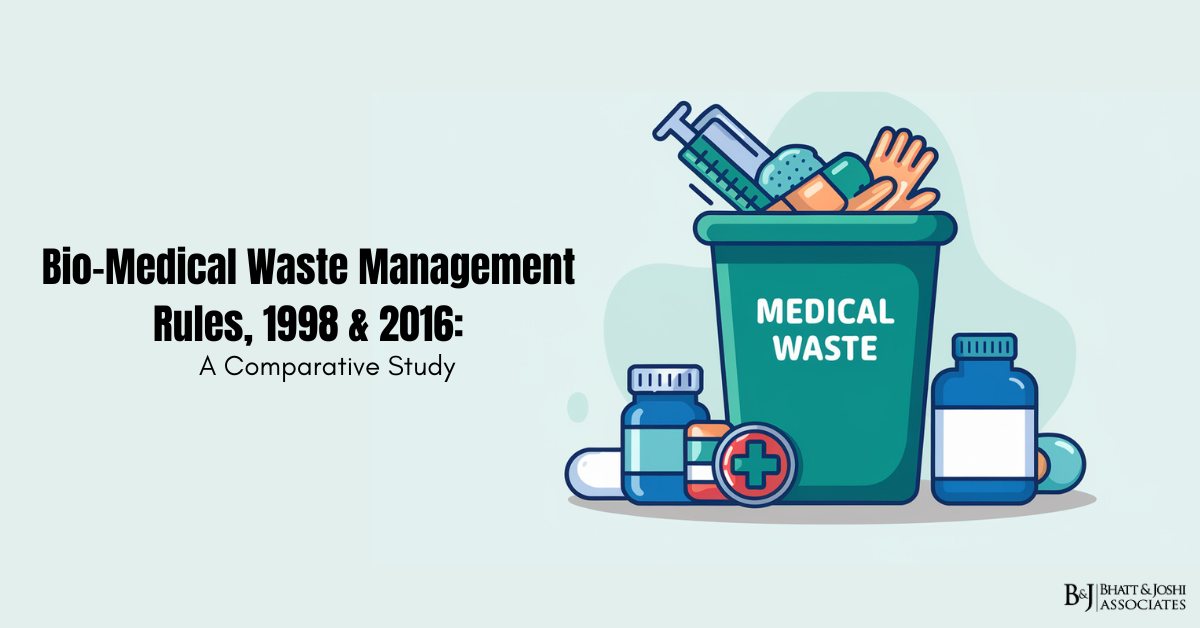Bio-Medical Waste Management Rules, 1998 & 2016: A Comparative Study

Introduction:
The study here tries to throw a light on the various aspects of the Bio-Medical waste Rules that has changed/amended from Bio-Medical Waste Management Rules, 1998 to Bio Medical Waste Management Rules, 2016. The Amendments/changes that has been done by the Government in the Bio Medical Waste management rules,2016 are for the better disposal of Bio-Medical Waste, through which the society can be a better place to live in.
Bio-Medical Waste:
Bio-medical waste is a waste which is generated during diagnosis or treatment of people or animals. This includes all the people and institutes which generate, store, collect, transport, treat, any forms of Bio-Medical Waste. There are many types of Bio-Medical wastes out which some are easy to treat and not harmful or contagious, and the other is very harmful as it can spread highly contagious diseases to the present and the future generation as well. This kind of waste can even be threat to the environment too as it can cause air, water, and soil pollution.
Many studies have stated that health care workers have very less or no knowledge about the disposal of Bio-Medical Waste which can be harmful and may seriously affect the environment. Due to the same reason, there is an increase in the awareness about the Bio-Medical Waste segregation and disposal. In our country there is a very much need of the awareness and knowledge about the same as many reports suggest that there is a lacunae in the practices among the many Health Care Workers. The Bio-Medical Waste Management Rules has been amended several times, but there is a lack of update among Healthcare workers and institutions.
Harmful Effects of Poorly Managed Biomedical Waste:
Biomedical waste when not disposed properly can pose serious risks to society and the environment through air emissions, contamination of water and physical contact.
Improper disposal refers to open dumping, unrestrained burning, and improper handling of waste during generation, collection, storage, transport and treatment.
Improper handling involves unsafe procedures followed during handling of wastes i.e. without wearing protective equipment, poor storage (high temp, high residence), transporting manually for longer distances, uncovered or unpacked containers instead of puncture proof bags, etc. all of which effect hospital workers in different ways.
The following groups are exposed:
Inside Health Care Centers:
staff- doctors, nurses, auxiliaries, stretcher bearers, patients, scientific and technical personnel, housekeeping staff, laundry, waste managers, maintenance, and lab technicians.
Outside:
In site and off site transport personnel, waste processing personnel, public, and rag pickers. Improper management of wastewater and sludge can result in contamination of air, soil and water with pathogens and toxic chemicals which may affect all forms of life. Inadequate waste management can cause environmental pollution, unpleasant odors, growth and multiplication of insects, rodents and worms and may lead to transmission of diseases like typhoid, cholera, etc. Infectious agents such as faeces, vomit, saliva, secretions, blood can cause serious health risks on individuals by affecting organs or systems like gastrointestinal, respiratory, eye, skin and cause Anthrax, Meningitis, AIDS, Haemorrhagic Fever, Hepatitis A, B, C, Influenza etc. Research and radio-immunoassay activities may generate small quantities of radioactive gases.
Infections Associated with Different Types of Waste:
| Organism | Disease Caused | Related waste |
| Viruses
HIV, Hepatitis B, Hepatitis A, C, Arboviruses, Enteroviruses |
AIDS, Infectious Hepatitis, Dengue, Japanese encephalitis, tick-borne, fevers, meningitis, etc. | Infected needles, body fluids, Human excreta, soiled linen, blood |
| Bacteria
Salmonella typhi, vibrio cholera, clostridium Tetani, Pseudomonas, Streptococcus |
Typhoid, Cholera, Tetanus, Wound Infections, Septicaemia, Rheumatic fever, endocarditis, skin and soft tissue infections, meningitis, bacteraemia | Human excreta and body fluids in landfills and hospital wards, sharps such as needles, surgical blades in hospital waste |
| Parasites
Wucheraria Bancrofti, Plasmodium |
Cutaenous leishmaniosis, Kala Azar, Malaria | Human excreta, blood and body fluids in poorly managed sewage system of hospitals |
Bio-Medical Waste Management Rules:
Bio-Medical Waste Management Rules were implemented under Environment Protection Act,1986 in our country on 20th July,1998. After that the Rules have undergone many amendments in the passing years. Bio-Medical waste Rules,2016 is the latest Bio-Medical Rules after significant and many changes done to Bio-Medical Rules,1998 keeping in mind the health care of the people. Primarily this waste was divided among various categories. Further multiple categories were clubbed to disposed in four colour coded bags. This was very hard to be remembered by the housekeeping and healthworker staff which formed a very weak section in the Bio Medical Waste Management system. It was found that the Bio-Medical waste generators had their own waste disposal techniques and systems which were not very effective or required significant improvement as they posed a threat to the public as well as the environment.
To undertake all these issues the new Bio-Medical Waste Management Rules were laid down by the ministry of Environment, Forest and Climate change under the Environment Protection Act, 1986 on 28th March, 2016.
Difference between Bio-Medical Waste Management Rules, 1998 and 2016:
The major changes are as follows: (1) the removal of multiple categories and to continue with only four color-codes (2) that no occupier was permitted to establish an on-site treatment and disposal facility if service of a common biomedical waste treatment facility (CBMWTF) is available within a distance of 75 km, and (3) changes in the form numbers of accident reporting, authorization, annual reporting, and appeal. The difference between Bio-Medical Waste Management Rules, 1998 and 2016 has been discussed by dividing it into various points and showing the difference between them.
Duties of the Occupier as per Bio-Medical Waste Management Rules:
Duties of the occupier are delineated better as it wasn’t delineated in 1998. There is pretreatment by disinfection and sterilization on-site of infectious lab waste blood bags as per the WHO guidelines Occupier ensures liquid waste is segregated at source by pretreatment, whereas, No pretreatment of waste on-site Chlorinated plastic bags, gloves, and blood bags were recommended. ETP is mandatory Occupier ensures to maintain BMWM register daily and on website monthly Annual report should be made available on the website within two years The occupier (30 bedded) establishes BMWM committee Records of equipment, training, health checkup, and immunization are compulsory whereas any of the above were not mandatory in the Biomedical waste management rules, 1998.
Duties of the CBMWTF as per Bio-Medical Waste Management Rules:
Duties are delineated better The occupier has to establish barcoding and GPS and ensure occupational safety of all its HCWs by TT and HBV vaccination Reporting of accidents and maintenance of records of equipment, training, and health checkup, whereas, in BMWM Rules, 1998 Duties are not delineated, better Barcoding and GPS not documented and vaccinations for HCWs not documented, Records not documented.
Accident Reporting:
Major accidents are reported to authorities and in annual report whereas, No specific reporting of accidents were mandated in BMWM Rules,1998.
Deep Burial:
As per rules 2016, Deep Burial is an option for only remote and rural areas and not in towns and villages with less than 5 lakhs population.
Chemical Treatment:
Changes to chemical treatment from 1% hypochlorite to 10% hypochlorite in 2016 which was again rolled back to 1%-2% in 2018.
Fetes:
No demarcation of foetus was mentioned in BMWM rules 1998 but the new amendment of rules in 2016 said Foetus younger than the age of viability is to be treated as human anatomical waste.
Drugs:
Antibiotics and other drugs and solid chemical waste suggested for incineration Cytotoxic drugs: return back to supplier and incineration up to 1200 C whereas, the rules, 1998 mentioned that all the drugs to be discarded in the black bag for cytotoxic drugs, destruction and drugs disposal in secured landfills
Liquid-infected waste:
Effluent treatment plant is mandatory, and effluent to conform to standards mentioned whereas rules, 1998 states chemical treatment and discharge into drains to conform to effluent standards mentioned.
Microbiology and biotechnology waste:
Rules, 2016 states the Pre-treatment of infectious waste as per the WHO guidelines whereas pre-treatment was not at all mandatory in rules, 1998.
Infected plastics, sharps and glass:
The infected plastics and sharps go in the red bag and the white container, respectively, and are sent to authorized recyclers. The glass articles are discarded in a cardboard box with blue marking whereas, infected plastics, metal sharps, and glass go in the blue container with disinfectant, and local autoclaving/microwaving/incineration is recommended.
Recycling:
A focus on recycling of plastic, sharps, and glass to authorized recyclers whereas, no such mention in rules, 1998.
Form I:
Changed to accident reporting from application for authorization.
Form-II:
Changed to Authorization or renewal of Authorization from Annual Report in rules, 1998.
Form-III:
Changed to Authorization for opening a facility for collectin, reception, treatment, storage, transport, and disposal of BMW from Accident Reporting in BMW Rules in 1998.
Form-IV:
Changed to Annual Report from Authorization for operating a facility for collection, reception, treatment, storage, transport, and disposal of BMW.
Form-V:
Changed to Application for filing appeal against order passed by the prescribed authority from Application for filing appeal against order passed by the prescribed authority in rules 1998.
FURTHER DEVELOPMENTS, Bio-Medical Waste Management Rules
Further, after publishing Bio-Medical Waste Management Rules, 2016 the Ministry of Environment, Forest and Climate change made some amendments and published Biomedical Waste Management (Amendment) Rules, 2018 on 16th March, 2018. In this amendment, typographical errors were corrected, rules regarding non-infectious wastes were updated.
Author: Arjun Rathod
Editor: Adv. Aditya Bhatt & Adv. Chandni Joshi
Frequently Asked Questions
1. What are the new biomedical waste management rules in 2016?
The Biomedical Waste Management Rules, 2016, introduced by the Ministry of Environment, Forest, and Climate Change (MoEFCC), brought stricter regulations for biomedical waste disposal. Key changes include:
- Expansion of rules to vaccination camps, blood donation camps, and home healthcare services.
- Introduction of pre-treatment of laboratory and microbiological waste before disposal.
- Mandatory barcoding and tracking of biomedical waste.
- Establishment of waste disposal facilities within 75 km of healthcare facilities.
- Increased frequency of reporting by hospitals and disposal agencies.
2. What are the rules for biomedical waste in India?
The Biomedical Waste Management Rules, 2016 (amended in 2018 and 2019) govern biomedical waste disposal in India. Some key rules include:
- Healthcare facilities must segregate waste into different color-coded categories.
- Waste must be stored for no more than 48 hours before disposal.
- Biomedical waste can only be treated at authorized Common Biomedical Waste Treatment Facilities (CBWTFs).
- Healthcare units must maintain annual reports on waste generation and disposal.
- Incineration and deep burial are prescribed methods for final disposal of specific categories of biomedical waste.
3. 2016 में नए जैव चिकित्सा अपशिष्ट प्रबंधन नियम क्या हैं?
2016 के जैव चिकित्सा अपशिष्ट प्रबंधन नियमों में महत्वपूर्ण बदलाव किए गए, जैसे:
- जैव चिकित्सा कचरे का रंग-कोडित अलगाव अनिवार्य किया गया।
- प्रयोगशाला और सूक्ष्मजीव अपशिष्ट का पूर्व-उपचार आवश्यक।
- बारकोडिंग और ट्रैकिंग प्रणाली लागू की गई।
- रक्तदान शिविरों और टीकाकरण शिविरों को भी नियमों के दायरे में लाया गया।
- कचरे का निपटान अधिकृत संयंत्रों में अधिकतम 48 घंटे के भीतर करना होगा।
4. What are the color codes for biomedical waste disposal?
Biomedical waste is classified into four color-coded categories:
- Yellow: Human tissues, body fluids, expired medicines (incineration/deep burial).
- Red: Contaminated plastic waste (autoclaving/microwaving).
- White (Translucent): Sharps like needles and scalpels (puncture-proof containers).
- Blue: Glassware and metallic implants (disinfection & recycling).
5. What is the role of hospitals in biomedical waste management?
Hospitals must:
- Segregate, store, and transport waste properly.
- Ensure waste is treated at CBWTFs.
- Maintain records and submit annual reports.
- Train staff on waste disposal guidelines.
6. How should biomedical waste be disposed of at home?
- Used syringes and needles should be collected in puncture-proof containers.
- Medical dressings and bandages should be kept in yellow bags.
- Expired medicines should not be thrown in household trash but returned to pharmacies or disposed of through incineration.
7. What is the punishment for violating biomedical waste rules?
Non-compliance can lead to:
- Fines up to ₹1 lakh.
- Imprisonment up to 5 years under the Environment Protection Act, 1986.
8. Who monitors biomedical waste disposal in India?
The State Pollution Control Boards (SPCBs) and Central Pollution Control Board (CPCB) monitor compliance and take action against violators.
9. What is a Common Biomedical Waste Treatment Facility (CBWTF)?
A CBWTF is an authorized unit where biomedical waste from multiple healthcare facilities is treated and disposed of safely.
10. What is the maximum time biomedical waste can be stored?
Biomedical waste must be disposed of within 48 hours from the time of generation.
11. What is the difference between hazardous and non-hazardous biomedical waste?
- Hazardous waste: Includes infectious, pathological, and chemical waste.
- Non-hazardous waste: Includes plastic packaging, food waste, and paper.
12. Can biomedical waste be recycled?
Yes, some biomedical waste like plastic syringes, IV bags, and glass vials can be disinfected and recycled as per CPCB guidelines.
13. What amendments were made to biomedical waste rules in 2018 and 2019?
- 2018 Amendment:
- Healthcare facilities with less than 10 beds must comply with waste disposal rules.
- Phase-out of chlorinated plastic bags and gloves.
- 2019 Amendment:
- Mandatory annual reporting on biomedical waste.
- Introduction of barcoding and GPS tracking for waste transport.
14. What precautions should healthcare workers take when handling biomedical waste?
- Wear gloves, masks, and protective gear.
- Follow hand hygiene protocols.
- Dispose of waste in color-coded bins.
- Avoid needle stick injuries by using safe disposal techniques.
15. How does biomedical waste impact the environment?
Improper disposal can lead to:
- Soil and water contamination.
- Spread of infections and antibiotic-resistant bacteria.
- Air pollution due to burning of waste.
16. Are dental clinics required to follow biomedical waste rules?
Yes, dental clinics must properly dispose of needles, extracted teeth, and chemical waste.
17. How should pharmaceutical waste be managed?
- Expired and unused medicines must be sent for incineration.
- Cytotoxic drugs must be disposed of separately under strict guidelines.
18. What is the responsibility of municipalities in biomedical waste disposal?
Municipal bodies must ensure safe transportation, treatment, and disposal of biomedical waste from clinics and small healthcare units.
19. What training is required for staff handling biomedical waste?
Healthcare staff must be trained in:
- Proper segregation and disposal methods.
- Personal protective measures.
- Handling emergencies and accidental spills.
20. Can biomedical waste be composted?
Only non-infectious biodegradable waste can be composted. Infectious waste must be incinerated or autoclaved.













